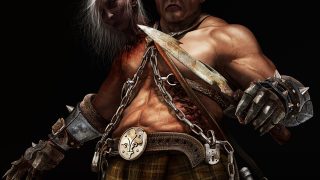
The Making of Salad
“Salad” is a computer generated image created in November 20 06. It is a tribute to the fantastic artist H.R. Giger and the classical painter Giuseppe Arcimboldo.
|
"Salad" is a computer generated image created in November 20 06. It is a tribute to the fantastic artist H.R. Giger and the classical painter Giuseppe Arcimboldo. |
|
|
|
|
 |
|
|
LIGHTINGI used 4 main lights and 2 arrays of 14 point lights. I often work with point light arrays to get soft area shadows. The more lights you use the better the soft shadows behave, but 7-10 lights in an array are usually enough for me. In Maya I would recommend to use spot lights instead of point lights, but in 3ds Max there is not much difference regarding the render time. This way of lighting a scene for me is the most intuitive way and it renders very fast in comparison to global illumination or "real" area shadows. The complete "salad" image for example only renders 10 minutes in 4000×4000 pixel. For this simple lighting technique it’s important that shadows and a decay are enabled for every light source.
SALAD IN THE TRAPThis is an alternative version that I developed after fi nishing the basic model. In the end I found the reduced portrait version is stronger, because it focusses more on the basic idea with the vegetables. This version was ment to create a story about wholesome vegetables stepping into a trap. At the same time it can look like the meat is the victim in a fi ght between vegetables and meat. I made this second version to play with the cinematic look. To modell the web I used the cloth physics of 3ds max reactor to lay a simple plane over the vegetables. Then I used the "edit mesh" modifi er to convert the edges of the polygons to a spline. After that I used the modifier "lattice" to create the joints at the connection points and
RELATED LINKSTill Nowak’s homepage >> Copyright 2007 by 3dm3.com |

 Till Nowak is working as a freelance media artist since 1999 in his own studio in Mainz, Germany. He studied “media design“ and graduated with his award winning shortfilm “Delivery“.
Till Nowak is working as a freelance media artist since 1999 in his own studio in Mainz, Germany. He studied “media design“ and graduated with his award winning shortfilm “Delivery“.






 [1] Wireframe Models
[1] Wireframe Models

 MODELING
MODELING









